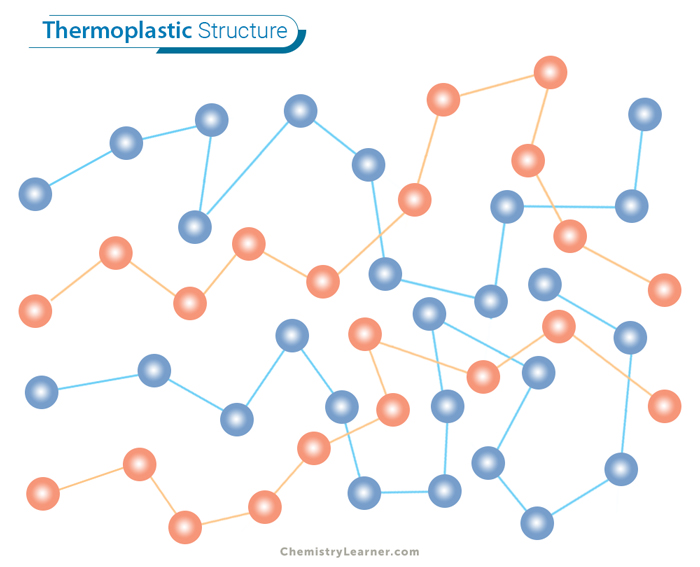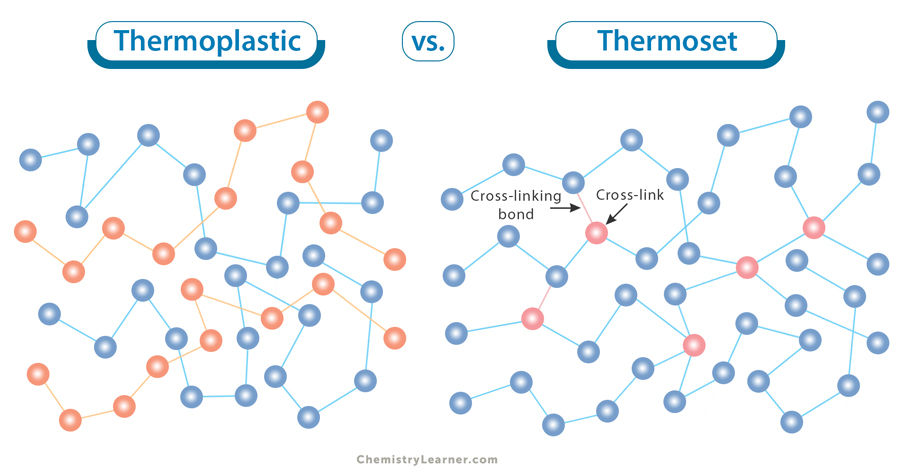Thermoplastic
Thermoplastic materials are a type of polymer that becomes soft and moldable when heated, allowing them to be shaped into various forms. These polymers can be melted, molded, and reshaped multiple times without significant chemical changes, setting them apart from their thermosetting counterparts. [1,2,5]
Properties
Thermoplastics exhibit various physical and chemical properties, making them suitable for various applications. [7]
1. Meltable: Thermoplastics can be melted and re-molded multiple times without significant chemical change.
2. High Strength-to-Weight Ratio: Many thermoplastics offer a good balance of strength and weight, making them suitable for lightweight yet durable products.
3. Chemical Resistance: Thermoplastics often have good resistance to chemicals, acids, and bases, enhancing their durability in different environments.
4. Transparent or Translucent: Some thermoplastics have optical clarity, making them suitable for applications where visibility is important.
5. Electrical Insulation: Many thermoplastics are insulators, making them suitable for electrical and electronic applications.
6. Low Toxicity: Thermoplastics are generally safe to use and have low toxicity levels, making them suitable for applications in food packaging and medical devices.
7. Easy Processing: Thermoplastics can be easily processed using various methods such as injection molding, extrusion, and thermoforming.
8. Temperature Resistance: Thermoplastics can withstand a broad range of temperatures, from low to high, depending on the specific material.
9. Affordable: Compared to other materials, thermoplastics are often cost-effective, contributing to their widespread use in various industries.
Thermoplastics Examples
Here is a list of thermoplastic polymers along with their properties and applications: [1-3,5,6]
1. Polyethylene (PE): One of the most widely used plastics, PE is known for its versatility and is commonly used in packaging, containers, and pipes. It comes in various forms, including low-density polyethylene (LDPE) and high-density polyethylene (HDPE).
2. Polypropylene (PP): PP is a robust and heat-resistant polymer used in various applications such as packaging, automotive parts, and textiles. It is known for its high chemical resistance and low density.
3. Polyvinyl Chloride (PVC): PVC is a versatile plastic that can be rigid or flexible. It is widely used in construction materials, pipes, cables, and clothing. PVC is known for its durability and resistance to chemicals.
4. Polystyrene (PS): PS is a lightweight and rigid plastic used in packaging materials, disposable cutlery, and insulation. It can be transparent or colored and is available in various forms, including expanded polystyrene (EPS) foam.
5. Polyethylene Terephthalate (PET): PET is commonly used for beverage bottles, food containers, and polyester fibers. It is transparent, lightweight, and has good barrier properties, making it suitable for packaging applications.
6. Polyamide (PA) or Nylon: Nylon is a strong and abrasion-resistant thermoplastic used in textiles, automotive parts, and industrial applications. It has excellent mechanical properties and can be molded into various shapes.
7. Polycarbonate (PC): PC is a transparent and impact-resistant plastic commonly used in eyewear lenses, electronic components, and medical devices. It is highly strong and known for its optical clarity.
8. Polyoxymethylene (POM) or Acetal: POM is a high-strength and low-friction plastic used in precision parts like gears, bushings, and valves. It has excellent dimensional stability and chemical resistance.
9. Polytetrafluoroethylene (PTFE) or Teflon: PTFE is a non-stick and high-temperature-resistant polymer used in cookware, gaskets, and bearings. It has excellent chemical resistance and low friction properties.
10. Polyethylene Glycol (PEG): PEG is a water-soluble thermoplastic used in various medical and pharmaceutical applications and personal care products. It is known for its biocompatibility and low toxicity.
Advantages
Thermoplastics offer numerous advantages over thermosets in various manufacturing processes. One key benefit is their ability to be melted and reshaped multiple times without undergoing chemical changes. This characteristic of thermoplastics makes them more versatile and cost-effective in recycling and reusability. [1-3,4,6]
Furthermore, the processing of thermoplastics is generally faster. It requires lower temperatures than thermosets, leading to energy efficiency and reduced production time. Their ability to be easily molded into complex shapes makes them ideal for various manufacturing applications.
Disadvantages
Thermoplastics, while versatile and widely used, come with their own set of disadvantages. One major limitation is the challenge of recycling these materials effectively. Unlike thermosetting plastics, thermoplastics can degrade in quality each time they are recycled due to the heat involved in the process. [1-3,4,6]
Additionally, some thermoplastics have limitations in terms of temperature resistance and mechanical strength compared to other plastics. This characteristic can restrict their use in applications that require high durability or resistance to extreme conditions.
Thermoset vs. Thermoplastic
Here is a table outlining the main differences between thermoset and thermoplastic materials: [2,5,7,8]
| Characteristic | Thermoset | Thermoplastic |
|---|---|---|
| Polymer Structure | Cross-linked structure | Linear or slightly branched |
| Chemical Behavior | Irreversible curing process | Reversible melting and solidification |
| Processing | Usually requires high heat and pressure during molding | Melted and molded at lower temperatures |
| Recyclability | Generally not recyclable | It can be recycled multiple times |
| Physical Properties | Generally harder and more rigid | Softer and more flexible |
| Thermal Stability | Excellent thermal stability | Sensitive to high temperatures, it can soften or deform |
| Chemical Resistance | Generally resistant to chemicals | Susceptible to chemical attack |
| Applications | They are often used in high-temperature applications, electrical insulation, and automotive components. | They are widely used in packaging, consumer goods, toys, and various molded products. |
| Examples | Epoxy, phenolic, melamine | Polyethylene, polypropylene, PVC |






